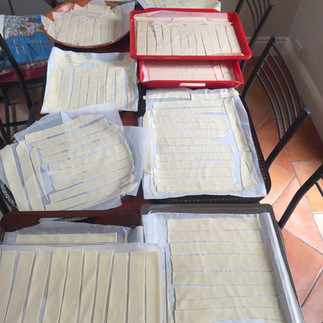Handy tips when making fresh pasta – pappardelle
- Silvana Franze

- Jan 29, 2022
- 4 min read
Updated: Feb 2, 2022
Did you wake up today and think to yourself, hmm I feel like making fresh pasta? I did. And as I was rolling out thin pasta sheets, I decided today would be Pappardelle Day.
There is literally nothing better than fresh pappardelle tossed through a rich tomato sauce or better still, a beef ragu. O.M.G.
I've recently discovered that our ragu is quite different to the so called traditional style, which has very little tomato in it. It may have something to do with the fact that we* love growing tomatoes in the backyard, and as such have more than we know what to do with. As a result tomatoes seem to go into just about everything. Hence our ragu with tomatoes. Who's to say which is correct? But I digress ...
If you've been to our pasta making classes, hopefully you have gone home to practice making the dough^ and are now quite comfortable handling long lengths of pasta sheets. It does take a bit of time to get the hang of it. And you will have noticed that no two days will produce the same result – in terms of dough texture, that is. The end result should pretty much be the same each time. So what do I mean?
The temperature and humidity have everything to do with how your pasta dough turns out. Some days it will be smooth and easy to handle. Other days it will be a bit sticky, giving you grief when attempting to wrestle long sheets. And other days still, it will be on the dry side, providing a good arm workout as you put it through the pasta roller (machine), or if you're extra traditional and use a rolling pin.
I'll list a few tips at the end on what to do when you experience any of the above. Here I want to focus on the lengths you handle. You're probably tempted to copy TV celebrity cooks and roll out a length of pasta that is around one metre. Don't. It's not necessary. And no one is watching. Instead keep the length to around 50 or 60cm. This avoids the sheet from piling up into many folds which will be tricky to separate and lay out onto your bench – especially if it is tacky.
Of course, if something goes horribly wrong, don't panic. Just fold the sheet over a few times and start rolling it through the roller from the widest setting again.
Soon you will feel comfortable making the pasta dough and handling the sheets – taking into consideration the tips below, and you will be more confident to make the lengths longer. Who knows, we may be seeing you on the next TV celebrity cooking show!
To cut into pappardelle strips, this is very straight forward. Once you have run the pasta sheet through the various settings to the thickness of your choice, lay it on the bench flat. Using a pizza cutter or pastry cutter, cut the sheet into the length you like, my suggestion is around 20cm. This is a good length when cooking the pasta, and a good length to eat. But you can always experiment here. Lastly, cut each 20cm sheet into wide strips. My suggestion is 2.5 to 3cm.
Make tomorrow "pappardelle making day" and the main tip I can give you is – have fun!
Caption: dough balls; an example of pasta sheet folding on itself – you'll want to work quickly before it sticks together; fresh pappardelle strips hand cut and laid out on trays to air dry; our tomato and beef ragu sauce; crinkle edged hand cut pappardelle; the finished result – who wants some?!
Tips:
If dough is dry:
– don't be tempted to add too much water when combining the flour and water. Better to have it dryer than too wet.
– once the dough is formed and covered in cling wrap or a tea towel, allow to rest for around 15 minutes. This helps soften it. You will notice the texture will not be dry.
– the process of putting the dough though the pasta roller over and over again helps soften the sheet. Which is why you should not start with dough that is soft and pliable. It will become one big tacky mess.
If pasta sheet is sticky / tacky:
– sprinkle with a little flour and rub all over evenly. Avoid using too much flour as it will give a floury taste.
– use semolina instead of flour. It can be expensive so use sparingly.
– lay your sheet onto baking paper for a short time. This helps it dry out. But don't wait til a crust forms.
– keep the length manageable. If it is too long and folds over onto itself, it may stick together.
How many strips per sheet:
– maximise your efforts by making the pasta sheet the full width of your pasta machine (approx 13cm).
– cutting the strips into 2.5cm widths produces four or five strips.
– use a knife if you don't have a pizza or pastry cutter.
– traditionally, 100g of pasta is served per person, keeping in mind that the ragu sauce will be rich with shredded meat. And you will want to mop up all that sauce with some Italian pane di casa. Yes I know, carbs heaven. Thank goodness for the protein! And if you're anything like my mum, serve with a few greens.
* by "we" I usually mean my Mum. She's the veggie grower extraordinaire
^ our dough does not contain egg, milk or oil. Only plain flour and water.



















Comments